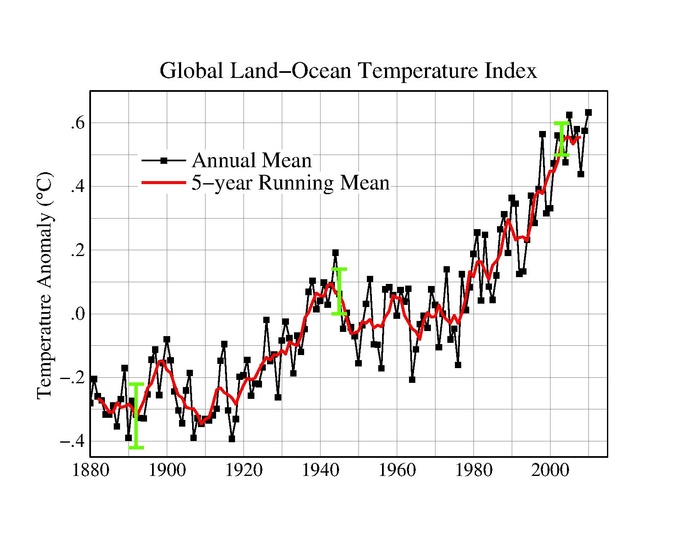Table of Contents |
The observations of scientists from year to year are consistently supporting theories of global warming and climate change.
A significant observation in the context of climate change is the record of global land and ocean temperatures since 1880, as shown in the graph below. We can see that, overall, there has been a significant rise in global temperature.

Another example is the melting and shrinking of glaciers and ice caps as a result of global temperature rise.
| Date | Changes in Glacier in Iceland |
|---|---|
| This is a photograph of a prominent glacier in Iceland with a large lake at its base in 1977. |

|
| By 2004, it had receded quite a bit. More of the rock outcropping is present on the right, and the lake at its base is shrinking. |

|
| By 2011, the glacier had begun receding up the hill, leaving large fissures in the rock. The lake at its base had completely dried up. |

|
Another clue to climate change and global temperature rise is the rise in sea levels worldwide. As the planet heats up, its ice caps and glaciers, as seen in the previous photo, are melting. The result is that more fresh water is joining the seawater in our oceans, and the average sea level is rising. Since 1880, sea levels have risen by almost 20 cm worldwide.

Earth naturally cycles between warmer and colder periods of climate. Periodic ice ages are examples of such changes. Climate change itself is a normal process, one that usually lasts thousands of years as it slowly shifts to its new average temperature, thus allowing species to adapt to the shift in temperature.
The significance of the current climate change is the speed at which it is changing. According to current scientific understanding, the recent rise in temperature, of about 1.53 °F over the last 130 years, is the quickest transition in Earth's history. Scientists expect that the average global temperature will continue to rise by approximately 2.5–10 °F over the next 100 years. Where we fall in that range will mostly depend on human activities and choices.
Earth's climate is determined by the following:
Our atmosphere is made up of 78% nitrogen, 21% oxygen, 0.93% argon, 0.03% carbon dioxide, and 0.07% other types of gases, such as methane. At the beginning of Earth's life, there were dramatic changes in its atmospheric makeup. In a relatively short period of time, it went from having 0% to 20% oxygen.
Nowadays, even though carbon dioxide and methane make up a minuscule part of the atmosphere, even small changes can have a huge impact. As carbon dioxide concentrations rise, so does global warming. However, it is not the most potent of greenhouse gases, despite its bad reputation. Methane is actually 30 times more potent than carbon dioxide because of its molecular structure. It will be important to manage greenhouse gases in respect to their potency as well as their quantity.
Source: THIS TUTORIAL WAS AUTHORED BY JENSEN MORGAN FOR SOPHIA LEARNING. PLEASE SEE OUR TERMS OF USE.